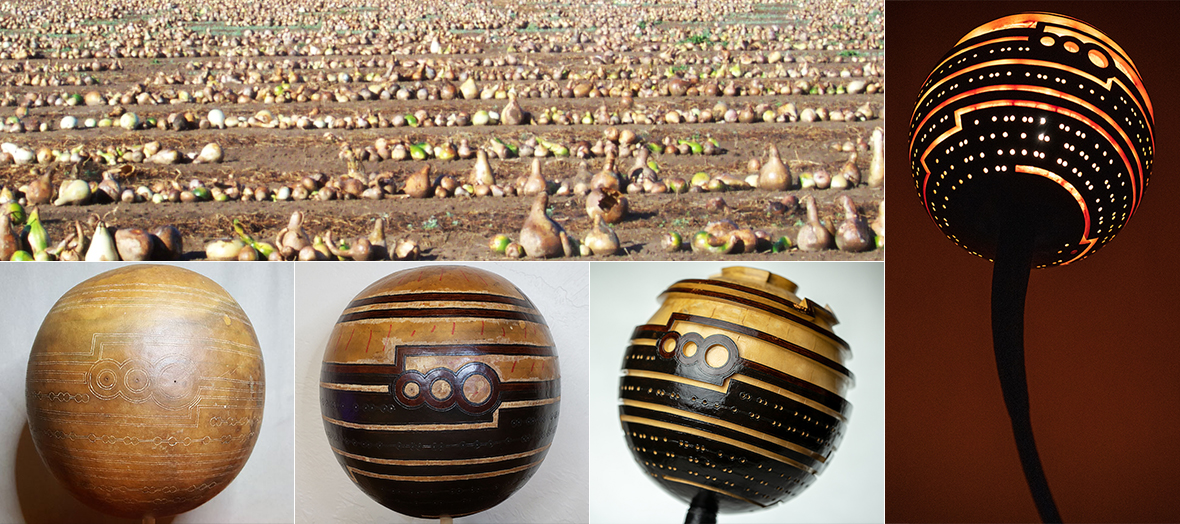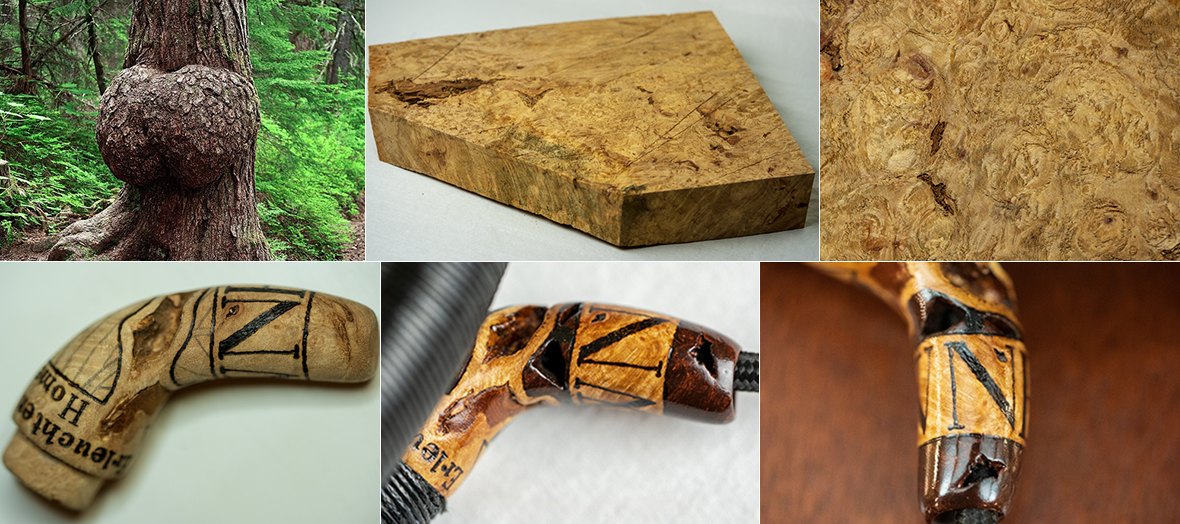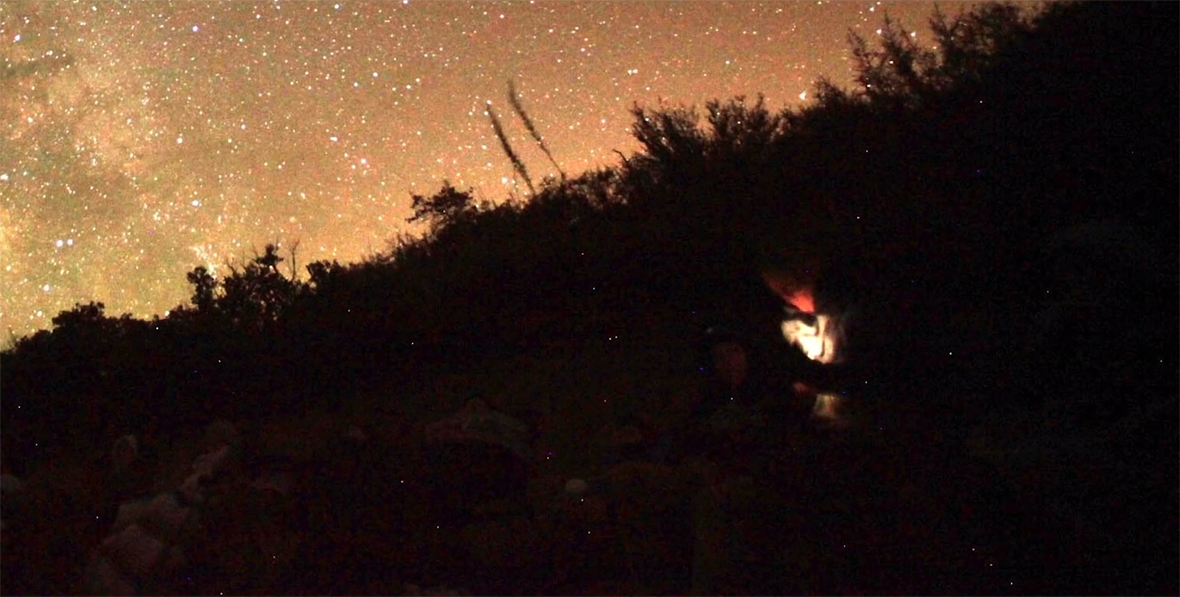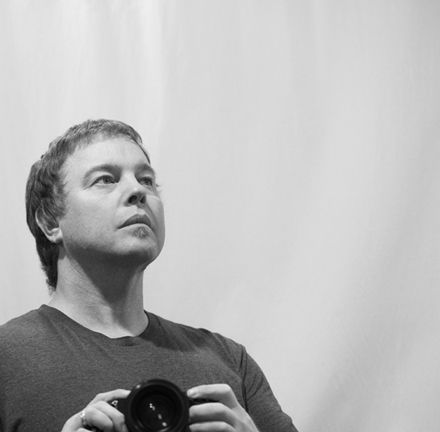The Lamps

Lamp Shade
Erleuchten Lamp shades are made from thick skinned, dense hard wood gourds meticulously handpicked for their shape, size, and quality. High density hard wood gourds result in an intricately worked, time durable, collectable piece of fine, functional art.
During your lamps shade creation, the wood is petrified using a number of techniques further ensuring the longevity.

While the shade is a work of art, bases are equally designed and built to the same level of fineness.
Erleuchten Lamps bases are made from the highest quality and some hard-to-find materials. A base is hand forged, hand carved, hand branded, hand wrapped, hand painted or stained, and the electric components are hand wired.
Each base is designed and crafted specifically for each piece of art to ensure the dimension, shape, and position best suits the piece. One base takes roughly two weeks to complete.
Lamp Base
The bulk of the base is hand forged from three pieces of metal repeatedly softened with fire then incrementally shaped after each firing. Once forged the bulk of the bas is then tightly wrapped with a fine waxed thread.
Lamp Base End Cap
The bottom end of the base is finished with a hand carved and stained piece of locally harvested maple burl. This end cap, designed as a continuation of the lamp shade, is hollowed for the electric cloth wrapped cord to run through and hand branded using pyrography. Burl is used in part for its beauty, and just as importantly used for its density diversity irregularities and grain fingerprint. Burl has an incredibly complex grain pattern impossible to reproduce, protecting your investment from potential forgers.

Lamp Base Electrical
The wire used is a material wrapped and PVC insulated cord used for its timeless and classic look and feel. A NOS (New Old Stock) BAKELIGHT, American made rocker switch is used to ensure tactile enjoyment when clicking the lamp on and off as well as generations lasting quality.
Lamp Bulbs
As much thought that goes into the design of the lamp just as much thought is put into how the piece illuminates your space. A dozen bulbs variety in shape, watt, coating, and gas are tested in every lamp. Bulbs cast different luminosity, shadow and light definition, and wood translucency and clarity.
Lamp Branding
Erleuchten Lamps are branded using pyrography. Pyrography branding, done by hand displays variability gifting each branded piece on an Erleuchten Lamp with a mark individual to the piece. The security of your investment in an Erleuchten Lamp is as important as the aesthetic, quality, and longevity.

Lamp build timeline.
From concept to completion the process to create an Erleuchten Lamp besides being filled with joy is also incredibly complex, arduous, and time-consuming requiring master knowledge of a number of disciplines.
Below is a very high-level color line representation of the process time allocation.
The Logo
Light Beings
Erleuchtens logo is designed after a light being and a being projected into our world during CE5 events hosted by Dr. Steven Greer and featured in his movie Close Encounters of the Fifth Kind - Contact Has Begun (2020).
Find below screenshots and video clips from the movie.









The Artist

"The founder of Erleuchten Lamps, based in Oregon, transforms humble gourds into ambient lights with a magical atmosphere." ~Robert Jobson, The Royal Editor
Earth is a master work of art while also being a canvas. Seen through Matthews eyes is abundant beauty where mundane items expose their vicissitude quality and transform into classic, functional fine art.
Photo: Matthew self-portrait.
The Q&A

The following Q&A was conducted for Aesthetica Magazine.
Your practice is both research- and craft-based. How do you combine these two processes?
Design with accompanying text.
When I decided to embark on this journey, from the first to last piece I told, tell, and will tell a story that spans esoteric and general history, current and future events, topics, and things. Merging research and craft-based (or what I like to call functional-art) is accomplished by incorporating the story behind a piece into something easy to notice in the design. An example of this can be viewed in the piece “Payseur”. The Payseur family was in part a Railroad family in the United States. The design of the “Payseur” have four large round circles accompanied with straight parallel lines. The lamp also represents an old railroad gas lamp I had when I was a child. The parallel lines represent railroad tracks, and the parallel lines in old railroad train engines and cars while the circles represent the trains wheels and lanterns used.
You’ve mentioned that you “see abundant beauty where mundane items expose their vicissitude quality” – what is it about this that appeals to you, and how does it inspire your research- and craft-based work?
Everything changes, everything has the appearance of change, every action has an equal or opposite reaction. My thought is that the outcome of change can in part be influenced by intension on a micro or macro level. Intension can be something as simple as how firewood is stacked. An intension to take a pile of firewood and stack it in a way that is beautiful. A piece of firewood can be described as mundane however, many pieces of firewood can be stacked into something beautiful. Intension changed the vicissitude quality of firewood by stacking it in a way of beauty. This is how I stack my firewood on our property. I use it as a feature in our yard, in fact the stack of firewood itself has a vicissitude quality as it grows or shrinks.
This way of thought inspires my work because I take something simple, mundane, a gourd which after it grows dies off, dehydrates, the exterior skin Molds. It looks ugly and rotten and is hardly noticeable laying on the ground. I have to take the gourd and process it, clean it, and once clean, change it into something incredibly beautiful with new meaning that will last for generations.
To what extent does an actual location inspire your work? You are currently based in Oregon – do you think your process and resulting pieces would be different if you lived somewhere else?
The inspiration for my work is not location based however, living in the mountains, where I feel most comfortable, is a comfortable and relaxing place to work.
How does working with different materials inform your practice?
Currently, I use the same materials for each piece so it doesn’t however this may change as I introduce other sources of materials.
Is the creation of your lamps driven by places in which you can observe or participate in environmental and social issues?
In some cases, yes, in others no.
Referencing the piece I used in a previous question, the “Payseur” can be both. Whereas “Intergalactic” is an interpretation of a potential.
Your art practice is called Erleuchten Lamps. Did you choose the word “erleuchten” from the German word “leuchten” or perhaps from “erleuchtung”?
Yes, “erleuchten” is a German verb meaning to illuminate either or I supposed both, physically and/or spiritually.
Although I am American my heritage is Germanic.
“Erleuchten” applies to my heritage, the work I do as I work with light, and spiritually.
When did you found the practice and what was the catalyst?
2014.
The catalyst built over a lifetime. Art, design, and love for architecture was always part of my life but I never considered these things anything more than a hobby.
As far back as I can remember I’ve had a light sensitivity. Ambient and non-direct lighting by necessity intrigued me and for a long time I intellectually dabbled in how to design lighting I did not find in the art, design, architecture marketplace that satisfied my aesthetic taste.
For thousands of years gourds have been used for musical instruments, carrying water, eating, and in more recent history carved for lighting. Typically, gourds are for the casual hobbyist spending a few hours cutting and carving a small thin-skinned gourd to place over a candle, or small Christmas style lights or even a light bulb you’d find in most homes.
My wife and I were looking at lighting for our home, not finding anything that appealed to us, it clicked. I can marry my lifelong experience in art and design and design and build a functional piece of very fine art.
Next step, figure out how to build something you can’t learn in a class or a book…
When did you create your first lamp, and what three things have you learned since that first creation?
The first lamp I worked on from 2016 to 2017. It currently sits in my shop as it was the first piece and was used to learn the techniques needed to make one of my incredibly intricate, unique, and complicated to make lamps. The name of the lamp is “One” and as of today is not for sale.
I knew what I wanted the finished product to look like but I had little idea on how to get there. I needed to build one and solve issues as I went along while fabricating custom tools as many of the tools needed for working the shade (gourd) to obtain the results I wanted were not available. Tools for gourd crafting are not designed for the finer details and techniques needed to make one of my pieces.
The base is made from metal. While the base on “One” is nothing like what the base is on succeeding lamps both internally and externally, the shape is similar. I had to experiment with an array of materials and learn the alchemy of the metal I finally chose to create the delicate and organic look of the base.
The light bulb used for each piece vary. Some bulbs are more opaque than others. Wattage varies as well producing a brighter or dimmer light. Some bulbs are clear. Variance is needed. Each lamp project light differently depending on the design. Each lamp shade has areas of the gourd worked down from a ~half inch thick skin of hard wood down to paper thin wood which creates a beautiful and relaxing amber colour. Other parts of the design have holes carved where light shines directly through and into the room. This is where the choice in bulb makes a big different in the experience when a lamp is turned on. Each lamp is a unique experience. A softer opaque bulb softens the shadow and light edges, while a clear brighter bulb will have sharper lines. On the bottom of the piece “Home”, a compass is carved. A compass modelling an antique nautical compass. I wanted to lines projected out to be very crisp so I used a bright clear bulb. The rest of the lamp shade displays colours of the ocean in swirls, showing the major warm and cold currents I mapped using satellite images.
Each lamp consists of a lamp shade, a base and an end cap. How is the creation of the base and end cap influenced by the lamp shade?
A lot of thought goes into how light emits from each lamp into a room. The light assists with the design in telling a story. The position of the lamp shade; height and angle, achieves this. The lamp base is custom made and hand forged, for each lamp.
The end cap also plays a part in telling a story the lamp tells sometimes continuing the design created for the lamp shade, other times as with “Payseur” the end cap designed to show pragmatism of a piece. In the case of “Payseur”, ruggedness of the generation who built the railroad system in the United States.
How does mathematics and specifically geometry inform each design?
Math is applied to every piece however; spherical and fractal geometry is used for many of the designs. The golden spiral and golden ratio were used in both “Tani” and “Intergalactic”. Both pieces used the same three-layer grid utilizing the golden spiral and ratio and as you can see, the finished designs look different though the same math-based layers were used.
My thought is math-based art make beautifully aesthetic art. Some examples in classic art where you find the golden spiral: Leonardo da Vinci Annunciation and Mona Lisa, Katsushika Hokusai Under the Wave odd Kanagawa, Raffaello Sanzio Madonna of the Goldfinch, Rembrandt The Anatomy Lesson of Dr. Nicolaes Tulp, Petrus Christus A Goldsmith in his Shop, and Piet Mondrian Tableau.
How does the material affect the emitted light?
The material used and its affect on how light is emitted is one of the reasons I decided to move into making lighting/lamps using a gourd for the lamp “shade”.
What is a gourd? A gourd is a hard-shelled non-edible fruit.
I use rare, incredibly difficult to find, thick-skinned, hardwood gourds with a spherical shape for my lamp shades. A bulb is positioned inside and in the middle. Light emits from the inside outward at all spherical degrees. The bulb plays a very important part in how the light projects, illuminates, and creates the intended effect. I pick from dozens of bulb watts, volts, shapes, filaments, and glasses to get the right lighting for every lamp.
When I design a lamp, I design the lamp to look beautiful with the light on or off, creating different moods and ambience in a room that change with the rotation of the Earth and direction from the sun.
Light emits in more subtle ways in areas of the design where wood is planed paper thin creating beautiful amber glow.
The base is hand forged from metal. Each base is made to angle each lamp shade and project light as designed.
How have the designs evolved from the Relic Collection to the Ironic Collection to the Naturalis Collection?
The evolution for most pieces in the first and third collections utilizes the same math for the base grids with the overlaying design work growing in complexity.
The first, “Relic” collection, I wanted to focus on the beginning the story I will tell therefore, the designs while complex are simple and elegant. I also wanted to include a “globe” so I designed “Home” which I spent months painting with a toothpick in order to get the texture wanted to show the major warm and cool ocean currents and, texture to the land on the continents.
The second, “Ironic” collection was made as political pieces demonstrating my frustration over the riots occurring in US in 2020 as well as the fires started all over my state of Oregon the same year. Over 200 arsons were caught in Southern Oregon starting fires which caused billions of dollars in damage destroying entire neighbourhoods displacing thousands of people from their homes and jobs. The smoke polluted our skies, caused health problems, and destroyed a good part of the year for many of us. The media called it the summer of love, it was more like the summer of hate.
The third, “Naturalis” collection is currently being worked on. The complexity in design, although based on the same math as pieces in the “Relic” collection is exponentially more complex drawing inspiration from math found in nature.
What are you learning now, whilst in the process of creating the Naturalis Collection?
Mostly woodworking techniques. I also need to fabricate more wood tools to accomplish what will be included in the coming collection.
What is it about “functional fine art” that appeals to you?
This ties into the quote mentioned earlier in this Q&A “’I’ see abundant beauty where mundane items expose their vicissitude quality”.
In our home, nearly every piece of furniture is not only a utility, it is also well designed and artistic, even in a small way. Blurring the line between utility and art is a beautiful thing where I appreciate both the artists creativity and efficiency in making something a person can both functionally use and admire.
I see time as our most valuable asset in this world and I do my best to use my time efficiently. If I am going to make art, I am going to make something functional, well-constructed, and beautiful.
AI-generated art is amongst the current discussions in the art world. Perhaps there is another question: can AI actually make art? What do you think, in light of your handcrafted works?
“AI” does not make art. The term “Artificial Intelligence” or “AI” is a misnomer. Software is artificial however; not intelligent. Software does what it is programmed to do. AI delivers results according to rules stipulated by the developers. An example is the rollout of Googles AI “Gemini” where a search result for “Viking”, “Founding Fathers”, “Canadian Hockey Players”, “Popes”, “Knight’s”, resulted in black men and women, “Asian” Nazi’s, and the gross absence of Caucasians while replacing historically Caucasian roles with anyone but.
AI generates art within the confines the developers put on the software.
I’ve talked with artists, architects, and designers who’ve used “AI” software to help their creative process acting at times as an artificial muse.
Personally, every “AI art” output I’ve seen was like looking into a nightmare devoid of soul, emotion, purpose, intention, reason and, creativity.
I draw inspiration from the shared human experience; love, emotion, ingenuity, religion, creativity, difference, etc. Each piece I make is unique, masterfully crafted by hand and has to be. A machine cannot physically craft and build an Erleuchten lamp. “AI” in the art world inspires me in no way.
I will never use AI in my work as an artist.
What are your current inspirations?
My current project, The Naturalis Collection “coming soon” is a representation of the universal invisible force colliding then merging with the physical and result of the merger. Currently I find inspiration in the current turning of the global power structure, the macro cycle which it resides, the parallelity of the two, and the result jump starting a new cyclical frame in time.
Evolving from the events in time from the previous cycle results in new life. In this case animals resilient enough to survive. In tandem with the “Naturalis Collection” I am drawing inspiration from animals that will be incorporated into “The Animalia Collection”, my fourth collection.
What projects and exhibitions do you have coming up this later this year and in 2025?
I am currently working on “The Naturalis Collection”, my third collection containing four pieces. I am in talks with a London England Gallery and a Scottsdale Arizona Gallery to show my work.